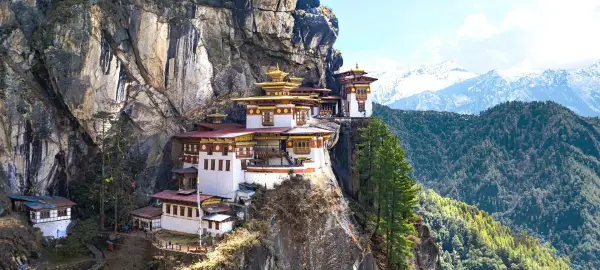Small Group Experiential Travel
Tour Code
BT1 Max Group Size
18 Start
Bangkok (BKK) End
Bangkok (BKK) Overnight In
Thimphu, Paro, Punakha, Phobjikha, Bumthang When To Go
Oct Activity Level
2 - Moderate? Tour Type
Cultural? - Overview
- Info & Inclusions
- Itinerary
- Map & Hotels
- Photos
- Dates & Prices
Highlights
- Comprehensive coverage of this fascinating and beautiful mountain kingdom
- Colourful Nalakhar Festival
- Bumthang - cultural heart of Bhutan
- Spectacular Tiger's Nest Monastery
- Bustling markets, mountain passes and spectacular valleys.
- Thimpu exploration
- Bumthang & Punakha
- Paro area sightseeing.
- Singles friendly (view options for single travellers)
Description
While cliches abound in describing Bhutan as the last Shangri-La, it's still surprisingly true, as the most hardened traveller will discover on our Bhutan tour.
The mountains that cut Bhutan off from the rest of the subcontinent for centuries also imbue it with a mystical air.
The terrain is remarkably unspoiled, the people friendly, and the culture rich and vibrant. The peace and serenity of the country soothe those who have to endure daily traffic jams and crowds back home.
You're likely to find that you might be the only tourist in some areas especially as you go further into the heartland of the country.
This is our most comprehensive treatment of Bhutan, a trip that gets you, literally and figuratively, to the very heart of this magical Buddhist kingdom.
The mountains that cut Bhutan off from the rest of the subcontinent for centuries also imbue it with a mystical air.
The terrain is remarkably unspoiled, the people friendly, and the culture rich and vibrant. The peace and serenity of the country soothe those who have to endure daily traffic jams and crowds back home.
You're likely to find that you might be the only tourist in some areas especially as you go further into the heartland of the country.
This is our most comprehensive treatment of Bhutan, a trip that gets you, literally and figuratively, to the very heart of this magical Buddhist kingdom.
Price Includes
- Breakfast and dinner daily
- Most lunches. Evening meals on tour will be taken mostly at hotels. In some locales we endeavour to break up the buffet dinners with a meal at a local restaurant but, overall, the imperatives of hygiene and quality dictate hotel meals.
- All transport, accommodation, sightseeing and entrance fees are included for sites noted as 'visited' in the detailed itinerary. Gratuities for drivers, restaurant staff, porters, local guides. Return air Bangkok-Paro-Bangkok is included in tour price, as is the cost of two overnights in Bangkok (airport) front and back.
- Our start and end hotel in Bangkok is located on airport property and, as such, hotel shuttle service is provided on a complimentary basis whether or not you have booked your flights with Adventures Abroad.
Exclusions
- International airfare to/from the tour. Tour Leader gratuities, some lunches, drinks, personal items (phone, laundry, etc), international (if applicable) air taxes, visa fees, and any excursions referenced as 'optional'. Airport transfers for Land Only customers. Optional trip cancellation insurance. Our post-reservation trip notes offer further guidance on shopping, not included meals, visas.
- Our start and end hotel in Bangkok is located on airport property and, as such, hotel shuttle service is provided on a complimentary basis whether or not you have booked your flights with Adventures Abroad.
- "Visa Fees" are not included in the tour cost
- We list these separately as they can change without notice. The "visa" for Bhutan is very easy and we acquire an entry permit on your behalf.
Trip Info
- Seasonality and Weather:
The main advantage of travelling in October/November is the clear, crisp blue sky that you witness grand views of some of the tallest un-climbed mountains in the world. It is the best time for trekking and travelling. The climate is cool and temperate and you can get lovely photography opportunities of willows shedding their golden brown leaves, the solitude of parks, and somber views of dzongs and monasteries.
Our dates usually also coincide with annual Teschus (festivals), which can change from year to year. Please refer to the detailed itinerary for more information. Our dates that are over a year away may be subject to change as festival dates are officially announced. - Transport and Travel Conditions:
Land transportation is via private bus or Land Cruiser type vehicle depending on group size and/or conditions. Air-conditioning/heat in vehicles is generally not available in this part of the world, but temperature should not be a serious issue. Road conditions are generally quite poor and can be bumpy, and as with all mountain roads the occasional delay can occur due to landslides or adverse weather conditions. The roads are also quite twisty on the mountain sections; if you suffer from travel sickness you should bring your usual remedy.
Porters are generally available at hotels but you must be able to manage with your baggage at airports.
This tour does not feature any arduous hiking or camping, but it is very busy and you will spend a lot of time on your feet at sites that are large and feature plenty of stairs and uneven surfaces. You must be prepared for some early starts and be able to endure some long travel days at moderately-high altitudes.
Because some of this tour involves locations approaching 10,000 ft, ALL PASSENGERS will require to complete a medical self-assessment form attesting to your suitability for such a journey. Those with pre-existing conditions that could be exacerbated by travel at high altitude or on poor roads, or persons with compromised immune systems and mobility problems, should carefully consider their participation.
Am I suitable for this tour? Please refer to our self-assessment form - Accommodation:
We will be staying in hotels with private bathrooms, and there will be hot water, though in more remote areas this may only be available in the morning and evening. Generally hotels are comfortable and often spectacularly located, though simple and maybe with some quirks that are charming more than anything.
Single rooms are limited and possibly smaller than twins. Porters are generally available (see 'Inclusions'). - Activity Level: 2
These are particularly busy tours that feature a lot of moving around, sometimes by train and short journeys on local transport. Walking tours of towns and cities are leisurely but you should be prepared to be on your feet for several hours. Some of our cultural trips that occur at high altitude and/or require greater independence with baggage handling (at hotels, airports, train stations) also fall into this category.
To learn more about the Activity levels, please visit our tour styles page. - Staff and Support:
Tour Leader throughout, local drivers, local guides at various locations. - Group Size:
Maximum 18 plus Tour Leader
View / Print Itinerary
- Day 1:Arrival in BangkokToday we arrive in Bangkok, our assembly point for our tomorrow's flight to Paro.
Overnight at Bangkok Airport area hotel.
Included Meal(s): Dinner - Day 2:Bangkok, Thailand - Fly to Paro, Bhutan - Drive to ThimphuThis morning we fly to Paro, Bhutan (via Druk Air).*
The airport at Paro is ranked as one of the most thrilling descents as the plane glides into the valley and one can see the chillies drying on farm roofs nearby. The crisp mountain air greets all visitors.
Upon arrival we then travel by road to Thimphu (2320m/7,609 feet), the capital, which is roughly an hour's drive from the airport. En route you can see the Iron Bridge Builder Monastery located in the opposite hillside. We will also cross the Chunzom (confluence of rivers) bridge where stupas in three styles (Bhutanese, Nepalese and Tibetan) are located.
Thimphu is a bustling developing city/town with little cafes, bookshops and handicraft shops lined along its streets. The main town center itself is just a small area, and it lends itself well to individual exploration as it is easy to walk around and navigate.
* Please note that this flight has commonly been rather "painfully" early - ie 5-6:00 am.
Overnight in Thimphu.
Included Meal(s): Breakfast and Dinner - Day 3:Thimphu: City SightseeingThe capital of the tiny Himalayan kingdom of Bhutan, Thimphu is a stronghold of traditional Bhutanese art, architecture and culture. Today we will enjoy some sightseeing in and around the city. We will visit the Buddha Statue, which is one of the biggest statues of the Buddha in the world and gazes upon the valley from a nearby hilltop. At the memorial chorten (stupa) you can see people from all walks of life circling the stupa structure in prayer. This chorten was built in memory of the third king of Bhutan.
We will see the Folk Heritage Museum as well as the Simply Bhutan complex; these are living museums documenting rural life in Bhutan. We will take time to stop at a weaving centre where one can see weavers at work. Built in the style of a traditional temple, the National Library houses religious books and manuscripts in Dzongkha and Classical Tibetan. Not far away is the imposing Tashichho Dzong. This 350-year-old monastery fortress is the present administrative centre of Bhutan, and the present king's office is also located in the building.
We will wander the stalls at the bustling Weekend Market. This is where many of the local Bhutanese buy their groceries etc. People from surrounding villages start arriving on Friday evening and come to buy and sell produce, ranging from dried chillies and yak butter to textiles and bamboo products.
A visit to the 12th century Changangkha Monastery offers a bird's eye view of the valley! Perched like a fortress on a ridge above central Thimphu, this 'guardian monastery' hums with pilgrim activity.
Overnight in Thimphu.
Included Meal(s): Breakfast and Dinner - Day 4:Thimpu - Phobjikha: Dochula Pass, Punakha & Wangdue ValleysThis morning we depart from Thimpu and head towards Phobjikha (3000m/9,800 ft). The first stage of our journey takes us to the Punakha and Wangdue valleys. This part of our journey crosses over the Dochula pass. Passes in Bhutan are considered sacred, and the Dochula Pass is home to the 108 Druk Wangyel chortens and a monastery. The hillside here is covered with prayer flags, and travellers are able to partake in the Bhutanese custom of hoisting prayer flags to increase their good fortune. When the weather is clear the Dochula pass offers a stunning 360 degree panoramic view of Himalayan mountain range. The pass is also a popular spiritual destination for both locals and tourists because an important temple that is located on the crest of Dochula pass.
We then continue onwards to Phobjikha, a bowl-shaped glacial valley on the western slopes of the Black Mountains bordering a National Park. Because of the large flock of black-necked cranes that winters here, it is one of the most important protected wildlife preserves in the country. Phobjikha is also considered to be a Baeyul or a 'hidden valley', which as per legend serves as a refuge from this world.
This afternoon we will visit a traditional Bhutanese farmhouse and see how life for the rural farmer continues at its age old pace.
Overnight in Phobjikha.
Included Meal(s): Breakfast, Lunch and Dinner - Day 5:Phobjikha: Gangtey MonasteryThe Phobjikha Valley is one of the most beautiful destinations in Bhutan, and the valley here is dominated by the Gangtey Goempa Monastery, which has been restored to its former glory. Perched on a small hill that rises from the valley floor, this monastery is the only Nyingmapa monastery on the western side of the Black Mountains. We will visit the monastery and gain some insight into the age old practice of Buddhism in Bhutan. The Gangtey Monastery likes to engage with the public and guests can observe age old practices here.
The Royal Society for the Protection of Nature has built a Black Necked Crane Centre in the valley which is situated on the edge of the forest and wetland along the main road of Phobjikha valley. The black-necked crane Information Centre has an observation room equipped with a high power telescope and spotting scopes for catching the best view of the cranes. The centre also offers display information that outline the natural and cultural history of the area. Cranes are usually in residence from late October to mid February though migration patterns cannot always be accurately predicted.
Bhutanese will hoist prayer flags for a variety of reasons, and one of the most popular form of flag are the lungta prayer flags. These are hoisted to increase one's good fortune and to ward off bad luck. Today we will be able to participate in the morning or evening prayer! We may also be able to partake in other activities like blessings. The monastery and Buddhist school is supported by private donations and any donations made will go towards providing food, books and clothes for the monks.
In the afternoon we will be able to enjoy an interesting hike in the area. This exploration will allow us to see the beauty of both the valley as well as the rural villages of the region.
Overnight in Phobjikha.
Included Meal(s): Breakfast, Lunch and Dinner - Day 6:Phobjikha - Bumthang: Trongsa & Chumey ValleysToday we will head for the Bumthang Valley (2800m/9,185 ft), taking us past the famous Trongsa Valley, which used to be the seat of the royal family. Trongsa Dzong straddles the ancient path to the east, and is an amazing architectural sight. The recently renovated Taa Dzong (watch tower) serves as a museum. This commanding dzong, high above the roaring Mangde Chhu, is perhaps the most spectacularly sited dzong in Bhutan, with a sheer drop to the south that often just disappears into cloud and mist. The dzong is a massive structure with many levels, sloping down the contours of the ridge on which it is built. Because of the dzong’s highly strategic position, on the only connecting route between east and west, the Trongsa Penlop was able to control effectively the whole of the central and eastern regions of the country from here.
After our visit to Trongsa we the continue past the picturesque Chumey Valley and later arrive in Bumthang. Chumey Valley is renowned for its yathra weaving, and there is a weaving centre en route that we will be able to visit. Yathra is a woolen embroidered cloth unique to Bumthang, and we will learn more about its production.
Bumthang is often considered to be the cultural heartland of Bhutan. Buddhism was introduced into Bhutan by the Guru Padmasambhava who was invited into Bhutan by a local king of Bumthang (at that time a unified Bhutan under one ruler did not exist). Bumthang has an individuality that charms its visitors and separates it from other regions. Comprising of four smaller valleys namely Tang, Ura, Choekhor and Chumey, the deeply spiritual region of Bumthang is shrouded in religious legend. Bumthang is also the traditional home to the great Buddhist teacher Pema Lingpa to whose descendants the present dynasty traces its origin.
The scenic region of Bumthang is dotted with monasteries and historic sites. Today we visit the Jambay Lhakhang and Kurjey lhakhang. The Jambay monastery is said to have been built by the Tibetan King Songsten Goembo. Inside the Lhakhang there are three steps which are said to represent the three ages. One step is for the age of the historical Buddha, the next is for the age of the Guru (also the present age) and the last represents the new age. It is believed that when all three steps sink into the earth the world as we know it will end.
There are three temples dotting thes sanctuary of Kurjey Lhakhang. The oldest monastery holds a body print of the Guru on a rock. The first King of Bhutan and the present Queen Mother built the second and the third temples respectively. This monastery complex is revered by the Bhutanese as one of the most sacred sites and there is a spring located just above the monastery complex which is believed to be blessed with curative properties.
Overnight in Bumthang.
Included Meal(s): Breakfast, Lunch and Dinner - Day 7:Bumthang: Jakar Festival / Mebartsho & Tamshing GoembaThis morning will be spent at the Jakar Festival,* one of the most popular festivals in Bhutan.
The Jakar Teschu celebrates the birthday of Guru Rinpoche, Padmasambhava. This is Bumthang’s official festival and celebrated for three days inside the gigantic Jakar Dzong. The term Tshechu means the tenth day which is auspicious in Bhutan. This festival is celebrated with mask dances and songs by both the Buddhist Monks and local villagers. It is an important event as all related folks from across the country comes together and discusses the important issue and prays together for a successful year.
This afternoon we will visit the revered site of Mebartsho -- 'the Burning Lake'. It is here that Pema Lingpa (a Buddhist discoverer of spiritual treasures) made some local discoveries. According to the legend Terton Pema Lingpa had a vision of the sacred treasures that Guru Rimpoche had hidden within the lake centuries earlier. However the people of Tang and the local ruler were cynical of his claims. In order to prove his claims, Pema Lingpa held a butter lamp in his hand as he jumped into the lake. After remaining under water for a long time he re-emerged holding a chest and a scroll of paper with the butter lamp held in his hand still burning bright. Thereafter, the lake came to be known as Mebartsho (the burning Lake).
* The festival we attend can vary from year to year, depending on dates, location, and other logistical considerations.
Overnight in Bumthang.
Included Meal(s): Breakfast, Lunch and Dinner - Day 8:Bumthang & DrangchelToday we will drive east of town through the valley where we witness rural life, picturesque villages and temples. We can drive up to visit the Ugyen Chholing Palace which is now a museum. Here we will gain an interesting insight into the life of an aristocratic family of the last century. The Palace has always been renowned for its religious history, and has been maintained beautifully. Here there are several exhibits through which we can gain a glimpse into Bhutan's religious, cultural and architectural heritage.
Overnight in Bumthang.
Included Meal(s): Breakfast, Lunch and Dinner - Day 9:Bumthang - PunakhaToday our journey continues to Punakha (1200m / 3,937 ft). En route we will stop at Chendibji Chorten!
Upon reaching Punakha we will visit the Punakha Dzong, arguably the most beautiful dzong in the country! The magnificent Punakha dzong straddles an island in the confluence of the Pho Chu and Mo Chhu (male and female tributaries of the river). This dzong was the second to be built in Bhutan and it served as the capital and seat of government until the mid-1950s. All of Bhutan's kings have been crowned here. The dzong is still the winter residence of the dratshang (official monk body). Today the dzong has been magnificently restored to befit its status in Bhutan’s history.
Overnight in Punakha.
Included Meal(s): Breakfast, Lunch and Dinner - Day 10:Punakha - Khamsum Yuelley MonasteryPunakha is the old winter capital of Bhutan, and today it is still the winter home of the Central monk body. Punakha was the capital of Bhutan and the seat of government until 1955, when the capital was moved to Thimpu. Punakha valley is famous in Bhutan for rice farming. Both red and white rice are grown along the river valley of Pho and Mo Chu, two of the most prominent rivers in Bhutan. Ritsha (meaning at the base of a hill) is a typical village in Punakha. The village houses are made of pounded mud with stone foundations. Each house is only two storeys high. Surrounding the houses are the gardens and the rice fields. The gardens also usually have fruit bearing plants like oranges and papaya among the organic vegetables.
Today we will visit the famed Chimi lhakhang where many locals go to pray for progeny. Also known as the "Fertility Temple," the single building site was originally built in 1499 on a short hill that had been blessed by rogue Buddhist leader Drukpa Kunley, known as the "Divine Madman." Drupa Kunley, also known as "The Saint of 5,000 Women" worked overtime to spread enlightenment through an active sex life. The monastery is located past scenic farming fields and a quaint village.
This afternoon we will enjoy a short hike to Khamsum Yuelley monastery, which was built by the Royal Queen Mother. The hike takes us through rice paddies and up the twirling trail to Khamsum Chorten where you can take a well deserved rest while admiring this impressive structure and the beautiful view of the valley below (Total hike time: 1-2 hours).
Overnight in Punakha.
Included Meal(s): Breakfast, Lunch and Dinner - Day 11:Punakha - ParoToday we drive to Paro, a route that sees us going back over the Dochula pass. En route we will visit the Simtokha Dzong, the oldest dzong in the country.
Paro is a thriving agricultural valley and is also the location of some of the holiest Buddhist sites in Bhutan. Before the construction of roads most of Bhutan's trade came through Paro either from Tibet via Tremo la or from the south via Haa. Paro Valley extends from Jumolhari on the Tibetan border to Chuzom which is the confluence of the Thimphu and Punakha rivers.
The town is an interesting mix of traditional architecture interspersed with handicraft stores, cafes and galleries. This morning we can stroll and explore the growing town. The town is situated below the Dzong (fortress / monastery) which overlooks the valley and is accessible via a traditional cantilever bridge. Near the bridge are chortens (prayer shrines) situated alongside the Ugyen Pelri palace. We will also visit the local monastery situated at one end of the town. If we are lucky we may be able to view an archery match as the local archery field is at the end of the town en route to the Ugyen Pelri Palace.
Overnight in Paro.
Included Meal(s): Breakfast, Lunch and Dinner - Day 12:Paro: Area SightseeingToday we will continue with our sightseeing in Paro. Just a short drive from town is the revered Kyichu lhakhang, one of Bhutan's oldest and most beautiful temples situated among the paddy fields. This is venerated as being as holy as the monastery in Lhasa. The small Dumste lhakhang was built in Tibetan style, and legend has it that it had flown from Tibet.
We will enjoy a visit to the Paro National Museum, situated above the Dzong in the ancient watchtower (at time of writing the exhibits are being viewed in an adjoining building as the tower is under repairs). Housed in a 17th Century watchtower, the museum has a unique character and beautiful panoramic views over Paro Valley. Opened in 1968, its collection of fine arts, paintings and bronzes are famous. Here we will also find displays of textiles, jewellery, and handicrafts. The top floor of the Museum is a chapel containing a "tree" depicting the main figures of the four religious schools of Tibetan Buddhism.
After our visit here we will visit the Rinpung Dzong which serves as the headquarters for the local government and the local monk body.
Overnight in Paro.
Included Meal(s): Breakfast and Dinner - Day 13:Paro & Tiger's Nest MonasteryToday we will visit the Tiger's Nest Monastery, a revered site for many Bhutanese.*
The Tiger's Nest Monastery, also known as Paro Takstang, is one of Bhutan's most recognized spots. This place is extraordinary! Here one dicovers a small collection of buildings precariously perched on a cliff, 900 meters off of the ground. It is stunning in its beauty and location. Without a doubt, visit to Bhutan would not be complete without seeing the Tiger’s Nest.
Due to it’s location, the only way to get to the monastery is by hiking. There are no vehicles that make the drive up to the monastery. However, for those who cannot hike the entire way, you can hire a horse to carry you most of the way there. On average it takes 4-5 hours to do the round-trip hike, plus one more hour to tour the monastery. The uphill walk/hike to the viewpoint takes roughly two+ hours through alpine forests, and we will either eat lunch on the trail or at the cafeteria which provides a good view of the monastery.
Along the way we pass prayer flags and stunning views of the valley below. At the halfway point (cafeteria stop) we are provided with a great view of the monastery -- the view seen on many postcards and guidebooks. Those who wish can select to finish their hike here, electing not to make the final climb.
After we tour Tiger's Nest we hike back the way we came. This evening we enjoy a farewell dinner.
* By now your Tour Leader will be familiar with you and your abilities; please confer with him/her on your suitability for this hike, as many travellers of average fitness have characterized it as "challenging." For those who choose to not do the hike, your Tour Leader will suggest other activities in the vicinity.
Overnight in Paro.
Included Meal(s): Breakfast and Dinner - Day 14:Paro, Bhutan - Bangkok, ThailandToday we fly back to Bangkok where we include your hotel stay this evening (dinner on your own). Your Tour Leader will be available to assist/provide advice re airport transfers for your onward journey.
Overnight in Bangkok (airport hotel).
Included Meal(s): Breakfast - Day 15:Departure from BangkokDeparture from Bangkok.
BON VOYAGE!
Included Meal(s): Breakfast
Regions Visited: South Asia
Countries Visited: Bhutan
Countries Visited: Bhutan
*The red tour trail on the map does not represent the actual travel path.
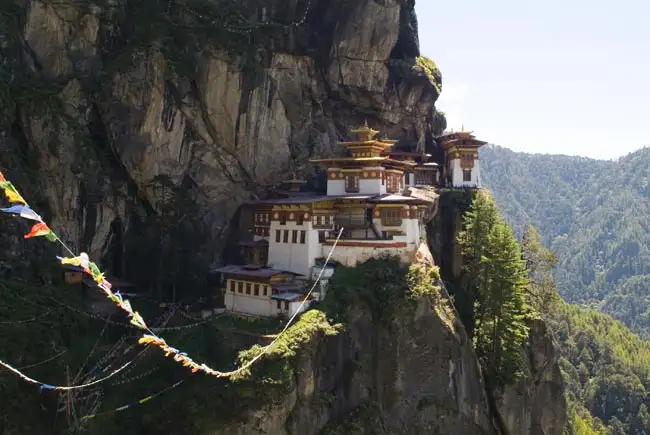
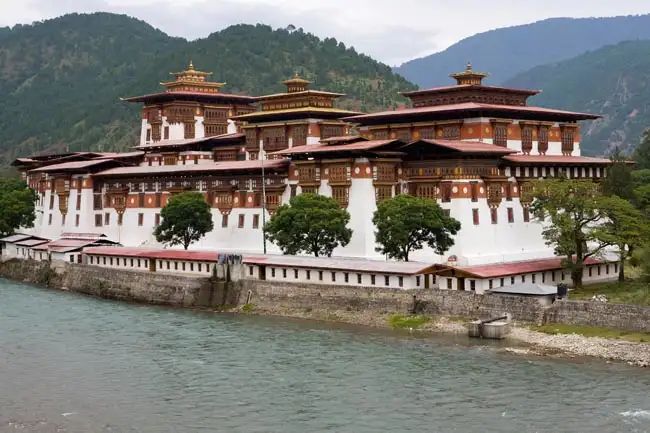
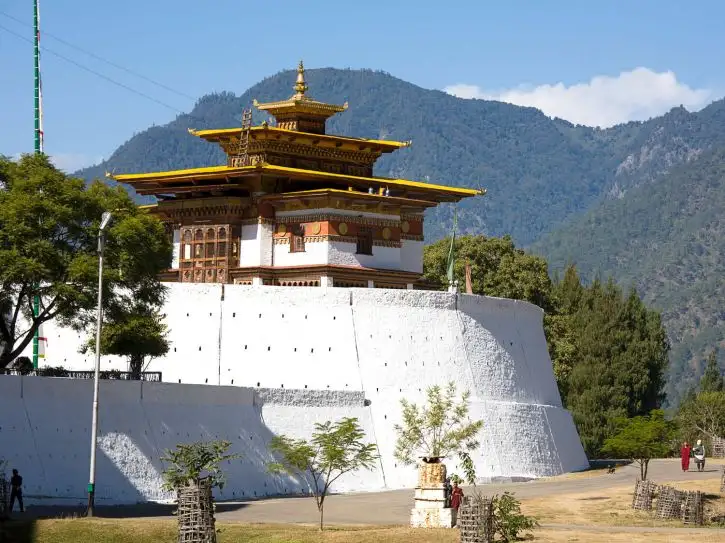
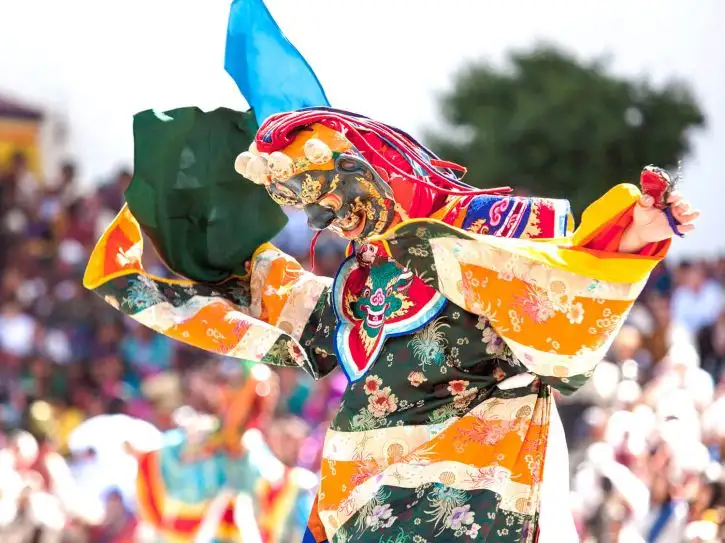

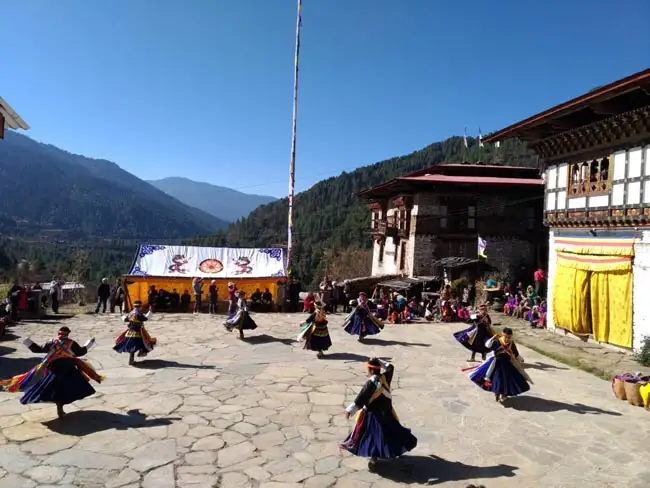
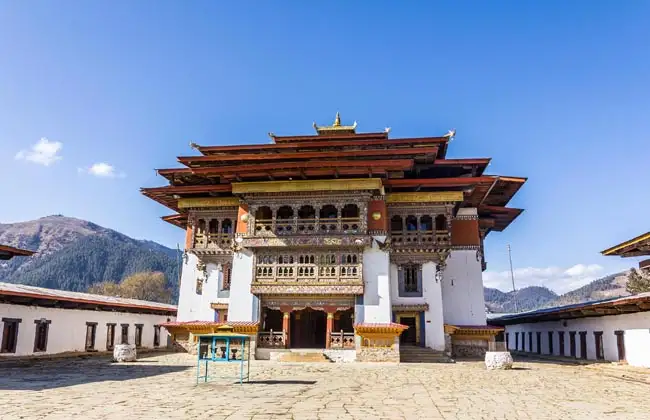
Excellent
Overall Rating
4.7
Extend Your Trip
This tour is part of a series that can be upgraded to make for a longer trip.
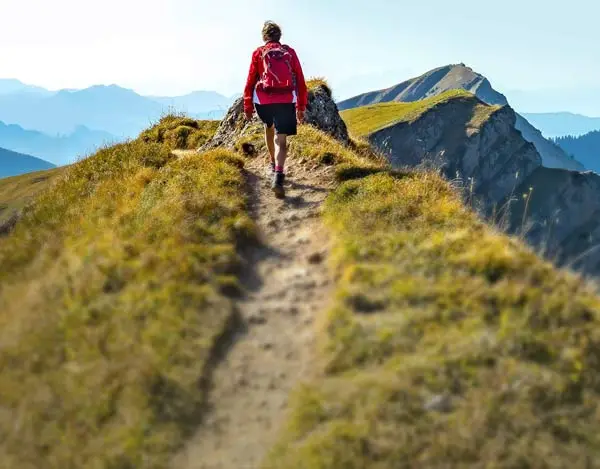
Fast and easy
Book this tour
Book your unforgettable adventure today! For any questions or advice, don't hesitate to contact us.
Have questions?
1-800-665-3998
- Final payment: Due 90 days prior to departure.
- Deposit: A non-refundable $500 USD Deposit is required at booking, covering the 'Land Only' cost, including all internal flights (taxes listed separately)
- Optional Single Supplement: $1090 USD (number of singles limited).
(View options forsingle travellers) - Transfering Tour or Date: Transferring to another tour or tour date is only permissible outside of 120 days prior to departure and is subject to a $100 USD change fee.
(Read our cancellation policy) - The return flight Bangkok-Paro-Bangkok is included in the tour price, as are two nights in Bangkok (airport). Tour dates over a year away may be subject to change until festival dates are announced.
Choose your departure date:
Prices below are per person, twin-sharing costs in US Dollars (USD). Pricing does not include airfare to/from the tour and any applicable taxes.
Prices below are per person, twin-sharing costs in US Dollars (USD). Pricing does not include airfare to/from the tour and any applicable taxes.
Frequently Asked Questions
- What is the maximum number of participants on a trip?Most of our tours carry a maximum of 18 participants; some tours (ie hiking tours) top out at 16. In the event that we do not achieve our minimum complement by our 90-day deadline, we may offer group members the option of paying a "small-group surcharge" as an alternative to cancellation. If all group members agree, we will confirm the trip at existing numbers; this surcharge is refundable in the event that we ultimately achieve our regular minimum. If the small group surcharge is not accepted, we will offer a refund of your deposit or a different trip of your choice.
- Can I extend my tour either at the beginning or end? What about stopovers?Yes, you can extend your tour either at the beginning or the end and we can book accommodation in our tour hotel. Stopovers are often permitted, depending on air routing. Stopovers usually carry a "stopover" fee levied by the airline.
- How do I make a reservation? How and when do I pay?The easiest way to make a reservation is via our website; during office hours, you are also more than welcome to contact us by telephone.
A non-refundable deposit is payable at the time of booking; if a reservation is made within 90 days, full payment is required. Some trips require a larger deposit. If international airline bookings require a non-refundable payment in order to secure space or the lowest available fare, we will require an increase in deposit equal to the cost of the ticket(s).
Early enrolment is always encouraged as group size is limited and some trips require greater preparation time.
Once we have received your deposit, we will confirm your space and send you a confirmation package containing your trip itinerary, any visa/travel permit related documents, invoice, clothing and equipment recommendations, general information on your destination(s), and forms for you to complete, sign and return to us. Your air e-tickets (if applicable), final hotel list, final trip itinerary, and instructions on how to join your tour, will be sent approximately 2-3 weeks prior to departure. - What about cancellations, refunds, and transfers?Please review our cancellation policy page for details.
- I am a single who prefers my own room. What is a single supplement?All of our tours have a single supplement for those who want to be guaranteed their own room at each location.
This supplement is a reflection of the fact that most hotels around the world do not discount the regular twin-share rate for a room by 50% for only one person occupying a room. Most hotels will give a break on the price, but usually in the range of 25-30% of the twin-share rate. This difference, multiplied by each night, amounts to the single supplement.
The conventional amount can also vary from country to country and some destinations are more expensive than others for single occupancy. In order to be "single friendly," the supplements we apply are not a profit centre for us and we do our best to keep them as reasonable as possible.
On most tours we limit the number of singles available, not to be punitive, but rather because many hotels allow for only a limited number of singles; some smaller hotels at remote locations also have a limited number of single rooms available.
Please note that most single rooms around the world are smaller than twin-share rooms and will likely have only one bed. - Do you have a shared accommodation program?Yes! If you are single traveller and are willing to share, we will do our best to pair you with a same-gender roommate. On most of our tours, if we fail to pair you, we will absorb the single supplement fee and you will default to a single room at no extra charge. At some destinations, however, where single rooms are not significantly discounted, or not at all, we may apply a "mandatory" single in the event that we cannot find you a share partner. This is usually 50% of the usual supplement, but can be as much as 100%. If applicable, this proviso will be noted on each tour page on this website, on your invoice, and in our tour date/price book (available for download under "Resources").
